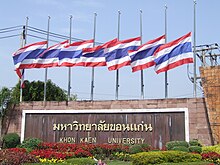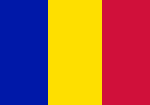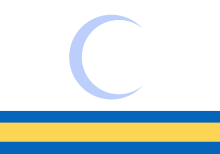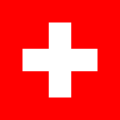National flag

A national flag symbolizes a state, its independence, independence and unity. Derived from this, they can also stand for other properties of the country, such as its national language, even if this is also used in other countries. The national flag is often used to demonstrate ownership claims over a territory, which is why there was, for example, the flag dispute between the USA and Panama in 1964 .
history
The national flag emerged from the flags of the ships, with which their nationality was once indicated. In the late 18th century, these flags established themselves as a national symbol that represents a country's citizens. This development towards the national flag was initiated by the emergence of the bourgeois nation-state, whose origins were the American and French revolutions .
The question of which national flag is the oldest still in use today cannot be answered simply. The answer depends on how you define the introduction, be it simple use or official legitimation by law or charter. Mostly reference is made to the Dannebrog , the flag of Denmark . According to legend, she fell from heaven on June 15, 1219 at the Battle of Lyndanisse . The oldest illustration of the flag is from the 14th century. However, it was not officially accepted until 1625 and declared a state flag in 1854. The flag of Sweden was first used as a flag in battle in 1569, and as a naval war flag from the 1620s . In 1663, the use was legally established. The flag of the Netherlands is mentioned for the first time in 1572, but it was only between 1630 and 1660 that the previously orange stripe turned into a red one.
The flag of Austria also claims to be the oldest flag in the world that is still in use. According to legend, the red, white and red flag was created in 1191 after the capture of Acre during the 3rd Crusade . The oldest illustration dates from the year 1230. In use as a naval war flag since 1786 , in 1918 it became the national flag of Austria.
Different types of national flags according to use
National flags can be used for civil, government, and military purposes. Many states therefore use different flags or modifications of the basic form of the national flag for these different areas. In some cases, a distinction is also made between use on land and at sea.
The national flag for civil use is called the civil flag . The word "civil flag" is sometimes incorrectly derived from the English name Civil Flag . The civil flag is, for the most part, the most well-known form of a country's national flag. Whitney Smith even describes the national flag as “today more that flag which every citizen of a nation is free to use.” The national flag for state purposes, as it is used by authorities, for example, is called the service flag . Here, too, the English name State flag leads to the occasional German translation "Staatsflagge". The war flag is the national flag used for military purposes. The civil flag at sea is called the merchant flag , the war flag at sea is also called the naval war flag . In addition, there are occasionally separate versions for different authorities, such as customs or the post office. Spain also has its own flag for yachts .
Most of the time, the different types of flags are created by adding the state coat of arms or another national symbol. Some states change the aspect ratio of their flag or deviate from the most common rectangular shape, for example with a swallowtail . There can also be practical reasons for this. The wind is often stronger at sea, so that flags fray faster on the flight part . A flag can then be used longer by cutting off the damaged parts. This can also be the reason for using the actual national flag only in the jack of an otherwise monochrome flag, such as the British Red Ensign . The design is seldom completely different from the other versions of a national flag. An example of this would be the national flag of Lithuania , where the service flag on the country differs significantly from the actual national flag.
In flag studies , the different types of national flag are identified by a vexillological symbol .
2: 3 ? Andorra Civil Flag

1: 2 ? United Kingdom Trade Flag ( Red Ensign )

15:22 ? Bolivia war flag on land

Design and meaning
The national flag is often used to express characteristics of the population and the country, historical connections or religious and political ideas. Sometimes with historically derived flags the meaning of the flag elements is only determined afterwards. They represent existence, present, origin, rule, property, loyalty, fame, belief, goals and prestige of an entire state. A third of the national flags show religious symbols. Of 196 national flags, 31 show Christian symbols , 21 one Muslim and 12 symbols of other religions.
The symbolism is therefore often a cause for controversy, for example when the national flag is changed in the course of changing a form of government. This happened in Portugal in 1910 , where the change of the flag after the abolition of the monarchy was stylized in the press as a flag war , or in Germany in the Weimar Republic . Between 2003 and 2006 there was a dispute in Italy over the colors of the national flag and in Iraq there has been disagreement about the appearance of the new national flag since the fall of Saddam Hussein . The 2004 proposal was heavily attacked because, in the eyes of many residents, it was too similar to the flag of Israel .
The most popular color for national flags is red, followed by white and about half of all national flags have a blue component. While in modern times the basic colors of the national flags are deliberately chosen for symbolic reasons, the colors of other national flags are often derived from the national coat of arms, such as the flag of Poland or Sweden .
National flags can also represent the solidarity of the individual parts of a country, for example in the flags of the USA , Malaysia or in the Union Jack , the flag of the United Kingdom ; or even symbolize the bond between different nations. This can be clearly seen in the Pan-Slavic colors , Scandinavian flags , the Pan-African colors , the Pan-Arab colors or the Central American colors .
Proportions and shape
The basic shape of the national flag is in most cases a rectangle, but its proportions can be very different. The aspect ratio can range from the relatively narrow flag of Qatar at 11:28 to the square flags of Switzerland and the Vatican . In addition, the mass production and failure to comply with these requirements has resulted in many commercial flags having a unit aspect ratio of 2: 3 or 1: 2.
The national flag of Nepal is the only national flag in the world to consist of two connected pennants instead of a rectangle.
11:28 ? Flag of Qatar

1: 1 ? Swiss flag

1: 1 ? Vatican City flag

~ 11: 9 ? Flag of Nepal

Front and back side
The definition of which side is the front and which is the back is not uniform. Although most countries see the side in front that has the mast on the left side from the observer's point of view, many Arab countries see the mast on the right side, corresponding to the reading direction of the Arabic script . This is indicated by a vexillological symbol ( ? ) In representations. There is a separate symbol ( ? ) For the back .
![]()
![]()
The front and back are usually identical, but there are exceptions. The flag of Paraguay shows two different seals in the center on the front and back. Such peculiarities cannot be traced back to flags from mass production. The flags are printed so that only the front is reversed on the back. This also leads to problems with flags that have a coat of arms or lettering, such as Saudi Arabia . Some states emphasize that their flag must not be mirrored on the back, others remove unbalanced symbols from the back. The flag of the Soviet Union only had a hammer and sickle on the front and only red on the back. The flag of the Sahara Democratic Arab Republic (Western Sahara) does not use a crescent moon and star on the reverse . When displaying this flag, it should be noted that the mast would be on the right side of the flag and not on the left. Different front and back sides are marked with a vexillological symbol ( ? ).
![]()

 ? Front of the flag of Paraguay
? Front of the flag of Paraguay

 ? Back of the flag of Paraguay
? Back of the flag of Paraguay

 ? Front of the flag of Saudi Arabia (the mast is on the right)
? Front of the flag of Saudi Arabia (the mast is on the right)
 ? Back of the flag of Saudi Arabia
? Back of the flag of Saudi Arabia


 ? Front of the flag of the Soviet Union
? Front of the flag of the Soviet Union


 ? Back of the flag of the Soviet Union
? Back of the flag of the Soviet Union

 ? Front of the flag of Western Sahara (the mast is on the right)
? Front of the flag of Western Sahara (the mast is on the right)
 ? Back of the flag of Western Sahara
? Back of the flag of Western Sahara
Legal requirements for use

National flags are used as symbols for states, both positively and negatively. Both the attachment to a nation can be expressed with them and their rejection by vilifying or desecrating a flag .
In most countries, the use and handling of the national flag is therefore determined by regulations and laws. These state that the national flag must be treated with respect and must not be degraded. For example, national flags are usually not allowed to touch the ground or to be placed under other flags. Some countries only allow the setting of the national flag in daylight or when the flag is also illuminated at night. Exact rules often also exist, in which places, in what relation to other flags the national flag may be used and also when it is so worn out that it has to be replaced.
On national memorial days in particular, the national flag is hoisted on public buildings and, if permitted, on private houses. In Peru and Latvia , all citizens are legally obliged to do so on national holidays, whereas in Saudi Arabia the use of the national flag is only reserved for the state and citizens are not allowed to use it privately. The same applied to India until 2002 . In Germany , the federal service flag (with the federal shield ) may not be used privately. On the other hand, the use of the civil flag ( federal flag ), the simple black, red and gold, is permitted . The use of a flag with a federal coat of arms that looks similar to the federal shield is tolerated, but not the use of the federal coat of arms without a flag (the federal coat of arms can be seen at the entrance of a ministry, for example). There are also restrictions on images of the flag on clothing. In Turkey this was completely forbidden for a long time, in Brazil only items of clothing above the belt can be decorated with the national flag.
In most countries, national mourning is expressed by setting the national flag at half-mast . However, in Saudi Arabia, Iraq and Iran , where the Islamic creed is written on the national flag , this is forbidden. In Spain and other countries, a black ribbon is pinned to the flag as a sign of mourning. If you cover a coffin with a national flag, it must be lifted up when the coffin is lowered into the grave in order not to sink into the grave.
Placing a national flag upside down signals an acute threat or danger in some countries. On the other hand, it can also be understood as a devaluation of the country. Often this is used as a protest. Mostly it happens out of ignorance of the correct order, for example with horizontal tricolors, like with the German or the Dutch flag . Only the flag of the Philippines can be hoisted upside down as a symbol for times of war. If a flag is hung vertically, the upper side of the flag is hung to the left from the viewer's point of view, so that the back of the flag is shown to the viewer. But there are also flags specially made for such uses, in which, for example, an included coat of arms has been rotated by 90 degrees, but they rarely have an official character.
Under United States Flag Act , a national flag that has worn down must be dignifiedly burned. A burning of the national flag as a protest is perceived as unduly; however, the Supreme Court has banned states from making provocative burning a criminal offense. Other countries absolutely forbid the burning of flags: In Germany, despising national symbols is a criminal offense. In Argentina , national flags are not allowed to be washed, because otherwise the "blood of the heroes of the fatherland" would be washed out. If a flag can no longer be used, it must be duly buried.
 ? Flag of the Philippines in wartime
? Flag of the Philippines in wartime
Burning a US flag
Not allowed everywhere: flags as items of clothing. Here the flag of Portugal as a headscarf
See also
- Proportions of the national flags
- List of national flags
- Flag identification key
- Common symbols and colors used in national flags
- National colors
Web links
- Flag protocol of the Federal Republic of Germany
- Flags of the World
- US flag etiquette
- UK flag flying protocol
supporting documents
Main evidence
- W. Smith, O. Neubecker: Coats of arms and flags of all nations . Battenberg Verlag, Munich 1981, ISBN 3-87045-183-1 .
- J. Louda: Flags and coats of arms of the world from A – Z , Bertelsmann Lexikon-Verlag, Gütersloh 1972, ISBN 3-570-06758-0 .
- Peter Häberle : National flags: Citizens' democratic identity elements and international identification symbols . Duncker & Humblot, Berlin 2008, ISBN 978-3-428-12802-0 .
Individual evidence
- ↑ http://www.austria-lexikon.at/af/Wissenssammlungen/Symbole/Fahnen-_und_Flaggenordnung
-
^ W. Smith, O. Neubecker: The signs of people and peoples: Our world in flags and flags .
Reich Verlag Luzern, 1975, ISBN 3-7243-0115-4 - ↑ German Society for Flag Studies e. V .: Glossary , accessed December 2, 2012
- ↑ Flags of the World: Yachts Ensign (Spain) , accessed December 2, 2012
- ↑ footnote . In: Der Spiegel . No. 49/2014, No. Abroad, December 1, 2014, p. 89.



























